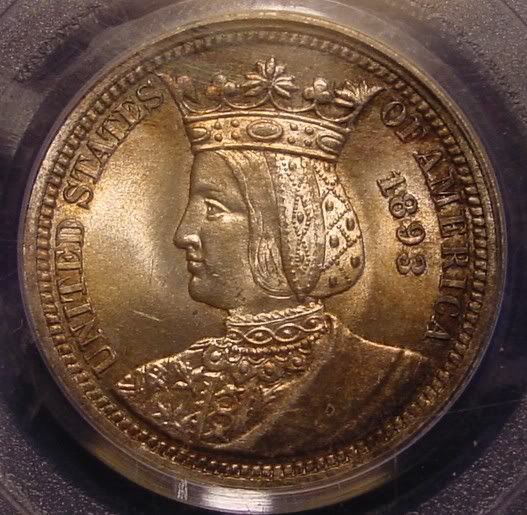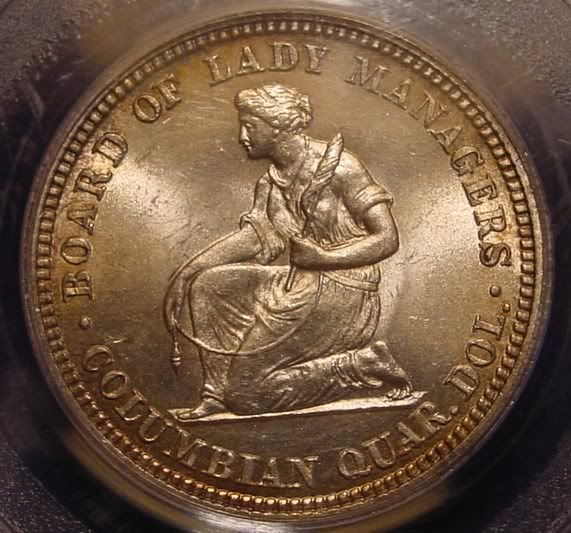Options
Introducing Mrs. Potter Palmer ... and the Isabella Quarter


This is Mrs. Potter Palmer (Try to say that name three times in a row.) was the Chairlady ("Chairperson" would not have been the proper terminology in 1893.) of the Columbian Exposition Board of Lady Managers. The existence Mrs. Potter's group was the direct result of a lobbying effort by Susan B. Anthony to give women a role in the running of the exposition. This medalet, which is made of aluminum, was one of many pieces that were issued in conjunction with this 19th century world's fair.
The ladies took it upon themselves to promote decorum an decency at the fair. For example they called for the fair to be closed on Sundays, but Gentleman managers overruled them. To break ever or perhaps show a modest profit, the fair had been open as much as possible during the six months that it ran. The Sunday openings also allowed the working classes greater access to the fair on the days that they were not at their jobs.
The ladies also objected to the "Little Egypt" exhibit which was in the midway of the fair, that attraction featured a lady, wearing dark make-up" who preformed a belly dance. The lady Managers viewed her performance as "lewd" probably because "Little Egypt" showed a bit more skin than the Victorians were used to showing and danced in a "provocative manner." The gentleman managers knocked down that objection too because the "Little Egypt" show made money, and the men enjoyed it.
The Lady Managers' pride and joy was the Women's Building at the fair which displayed the achievements of the fair sex. The building was designed by a lady architect, and its displays featured domestic arts such as needlecraft, fashions and other arts and crafts connected with homemaking.


Both the Board of Lady Managers and the Board of Gentlemen Managers received $10,000 stipends from the government. The Lady Managers came up with what seemed to be an ingenious plan. They took their stipend in the form of 40,000 Isabella commemorative quarters, which they planned to sell for $1 each, thus quadrupling their money. The Isabella Quarter was sold at the Women's Building, but from I have read, the advertising for it was limited, and the place where it was sold was not easy to find. The coin was also not very popular because it was priced a $1.00 at a time when the Columbian half dollar, also priced at a dollar did not sell very well. In the end the Lady Managers sold only a little over 14,000 quarters, and some them were priced at little as 35 cents apiece.
This is where Mrs. Potter (Bertha) Palmer came to the rescue for modern coin collectors. At the end of the fair the unsold quarters were slated to go back to the mint to be melted. Mrs. Palmer and some of her friends bought up 10,000 of the coins at face value ($2,500) thus saving them from destruction. Had they not taken that action the Isabella Quarter would be a scarcer and more expensive coin today.
Retired dealer and avid collector of U.S. type coins, 19th century presidential campaign medalets and selected medals. In recent years I have been working on a set of British coins - at least one coin from each king or queen who issued pieces that are collectible. I am also collecting at least one coin for each Roman emperor from Julius Caesar to ... ?
0
Comments
<< <i>Great looking example of a very tough SC$1 to find in any condition
Yes, that is only the second example I've seen offered in about 15 years of looking. I was out bid on the first one despite the fact that I bid several hundred dollars more than ten years ago. This one also cost several hundred dollars, and it was certified. The first one was raw.
One of my great-grandfathers and great-grandmothers first met at the Columbian Exposition. He was an immigrant from Sweden living in Chicago and she was from Pekin, Illinois. As a young girl she had used a railroad handcar to get to school (her father worked for the railroad).
--Severian the Lame
I happened to post a thread about the upcoming MSNS show and the fact that Craig Whitford was the auctioneer. I was looking through some lots in the preview and one contained an assortment of medals/tokens that was interesting. hidden in the group was an HK-243a that was pristine, I was shocked to find it and figured I would win the group easily and sell off everything else. when the bidding strated there was two of going at it and when I looked around to see who my competitor was I saw Paul Cunningham!! I held on for another bid and stopped to let him win at a lower price.
after the lot closed I walked over to him, gave him a card with my phone number, what I was interested in and said good night with the hope that he would call. about two weeks later he called and we arranged the deal with the medal arriving about three weeks later. I had NGC certify it and I found myself with an MS64 example of a medal I found by chance. I waited and waited to find the matching HK-243b Manager General but never could so I sold it several years ago at a local show and I believe the dealer -- Dave at Executive Coin -- still has it. the design is elegant, the detail very exquisite and especially striking in aluminum.
when I originally started looking for one I did some online research of the Lady Managers to get an idea of how the medals may have been distributed. as best as I could find there were perhaps 20-30 women involved, so I wonder if the medal may have been given to each?? this is one that it would be nice to trace a pedigree on, but my research is mostly speculation, the medals may have been sold widely and only a few dozen or so have survived.
if I can find pictures I'll post them later this evening.
https://imdb.com/name/nm1835107/
Steve
<< <i>how inconceivable is it to find THIS in a junk lot thrown together by the auctioneer??!!?? >>
Not that inconceivable. The late Steve Tannenbaum, who was the nation's leading expert on exonumia, told me about a large lot of "junk" tokens that he cherry picked from a Heritage auction. He said that he spotted a piece which he sold for $10,000.